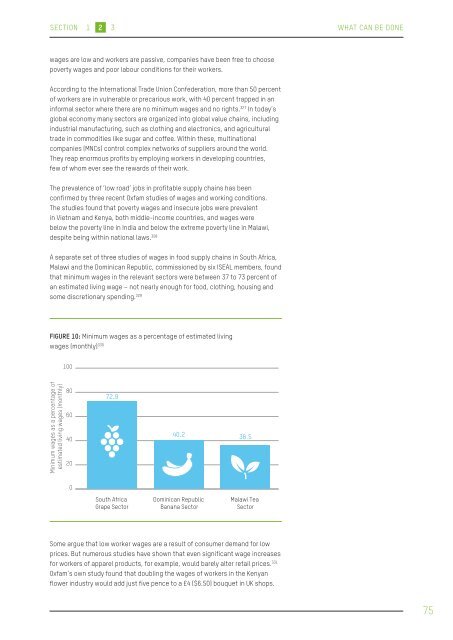1FW2e8F
1FW2e8F
1FW2e8F
You also want an ePaper? Increase the reach of your titles
YUMPU automatically turns print PDFs into web optimized ePapers that Google loves.
SECTION 1 2 3<br />
WHAT CAN BE DONE<br />
wages are low and workers are passive, companies have been free to choose<br />
poverty wages and poor labour conditions for their workers.<br />
According to the International Trade Union Confederation, more than 50 percent<br />
of workers are in vulnerable or precarious work, with 40 percent trapped in an<br />
informal sector where there are no minimum wages and no rights. 327 In today’s<br />
global economy many sectors are organized into global value chains, including<br />
industrial manufacturing, such as clothing and electronics, and agricultural<br />
trade in commodities like sugar and coffee. Within these, multinational<br />
companies (MNCs) control complex networks of suppliers around the world.<br />
They reap enormous profits by employing workers in developing countries,<br />
few of whom ever see the rewards of their work.<br />
The prevalence of ‘low road’ jobs in profitable supply chains has been<br />
confirmed by three recent Oxfam studies of wages and working conditions.<br />
The studies found that poverty wages and insecure jobs were prevalent<br />
in Vietnam and Kenya, both middle-income countries, and wages were<br />
below the poverty line in India and below the extreme poverty line in Malawi,<br />
despite being within national laws. 328<br />
A separate set of three studies of wages in food supply chains in South Africa,<br />
Malawi and the Dominican Republic, commissioned by six ISEAL members, found<br />
that minimum wages in the relevant sectors were between 37 to 73 percent of<br />
an estimated living wage – not nearly enough for food, clothing, housing and<br />
some discretionary spending. 329<br />
FIGURE 10: Minimum wages as a percentage of estimated living<br />
wages (monthly) 330<br />
100<br />
Minimum wages as a percentage of<br />
estimated living wages (monthly)<br />
80<br />
60<br />
40<br />
20<br />
72.9<br />
40.2 36.5<br />
0<br />
South Africa<br />
Grape Sector<br />
Dominican Republic<br />
Banana Sector<br />
Malawi Tea<br />
Sector<br />
Some argue that low worker wages are a result of consumer demand for low<br />
prices. But numerous studies have shown that even significant wage increases<br />
for workers of apparel products, for example, would barely alter retail prices. 331<br />
Oxfam’s own study found that doubling the wages of workers in the Kenyan<br />
flower industry would add just five pence to a £4 ($6.50) bouquet in UK shops.<br />
75


